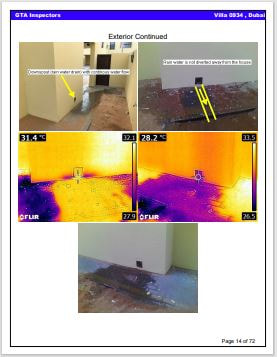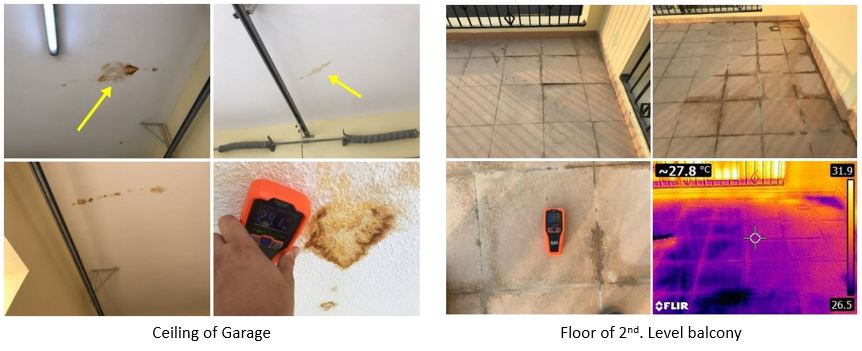0 Comments
This is what we observed during a recent inspection of a 4 Bedroom villa with large balcony on top of the garage. Signs of moisture intrusion on the garage ceiling that was confirmed by the condition of the balcony on the 2nd. floor.
Make sure you do a "pre-handover" inspection of the water proofing to prevent damages like this, which can be costly ! 1. The house is fine, but I could make it look bad.
As the housing market recovers in the UAE, more buyers and sellers will be getting introduced to one of the most nerve-racking rituals in real estate: the home inspection. An inspection, which usually occurs after a buyer has made an offer, is meant to be an objective analysis of a home’s condition. Twenty years ago, 75% of purchased homes in North America were inspected; today, it’s 95%, according to the American Society of Home Inspectors, a Des Plaines, Ill.-based industry trade group. The trick is finding an inspector who can relay the critical information and put it in context. Communication and a strong, yet easy to understand inspection report is key for home buyer to see the fact and take the decision accordingly, removing any subjectivity from the mix. 2. Get the house, not the inspection. Most realtors and real estate lawyers recommend including inspection condition in purchase contracts. But in most cases the law doesn’t actually require an inspection. And in hotter markets, some buyers are opting to skip them. In a competitive bid situation “an offer for $880,000 with no inspection condition will likely win over a $900,000 offer with an inspection contingency. Of course, skipping an inspection can leave you in a different kind of hot water. If an inspection turns up a home defect, the seller will be under pressure to either drop their price or fix the problem. If the buyers waive that option, and find a defect afterward, they’re on their own when it comes to repairs. 3. Qualifications? I may not have any… Only about two-thirds of the states and provinces in North America have laws regulating home inspectors. Luckily in the UAE, there are strict license regulations for a company to offer property inspection services. This is key because If a not-so-sharp/unqualified inspector misses a defect, this can be costly or even pose safety hazard for the home occupants in the future It is always advised that you choose a company that is licensed and does not delegate the actual inspection to unqualified staff or skilled workers. In fact, in UAE, one of the licensing requirements is a BSc. in civil engineering in addition to many years of experience in the same field. In addition, a company that is an active member of an international association of home inspectors, such as InterNACHI, will give you the confidence and you may be able to rest assured that you will get a thorough assessment of your valuable purchase. 4. I’ll cut corners to keep the agents happy. The inspector ideally should work only for the client. But home inspectors also try to build relationships with agents and brokers to get more business, and that can give them an incentive to play down any problems with a house. Sometimes, the buyer’s agent tries to lean on the home inspector so as not to blow a deal. This is complete unethical business practice! Experts say homeowners should be wary if an agent or broker that tries to discuss the inspection directly with the inspector and cut out the client. 5. Feel free to watch. It happens: Some home inspectors are so thorough they can scare a client out of a deal. One way for a buyer to avoid that fate is to accompany the home inspector room-to-room during the actual inspection. You’ll learn a lot about the home that way, and you won’t be surprised when the home inspector comes up with a long list of fixes. 6. You should bring me in earlier. Traditionally, inspections don’t happen until after the buyer has made an offer: the practice is so standard that most inspectors don’t think to question it. But having a home inspected before submitting an offer is a relatively frequent practice in parts of the united states, and some real-estate agents think it’s a practice worth adopting more widely. Researchers at the real estate group Redfin in San Francisco say that offers paired with pre-inspections were successful 21 % more often than other offers, and that San Francisco home buyers whose offers included a pre-inspection were more than twice as likely to win a bidding war as those without one. “It tells the seller that you already know what’s wrong with the home, you still want to buy it, and you’re not going to ask them to pay for repairs later,” 7. To find a serious problem, you may need someone else. Inspectors admit that there are some problems they aren’t in a good position to detect. “An inspector can look at the exterior of an addition or a recently-remodeled basement, but without pulling the permits, there’s no way of knowing what’s behind the walls”. Luckily, the advance in modrn technology and new tools has made it much easier for home inspectors to detect issues that can not be seen with the normal eye. Make sure you hire an inspection company that deploy state of the art tools and equipements. 8. I can make money from the problems I find. There’s always the potential for conflicts of interest in a business where one hand washes the other. Many home inspectors either used to be general contractors, or still do such work on the side. And it isn’t unheard of for an inspector to steer a home buyer to a pal’s firm, or even to the inspector’s own contracting business, to repair the very same flaws the inspection turned up. Be mindful as this is a common practice in the UAE. Choosing a property inspector that has no alliances with any repair or maintenance companies is prudent.
Defective components may create safety hazards as well as functional deficiencies to the garage door assembly. The following facts demonstrate the dangers posed by garage doors:
Inspectors should not attempt to fix any garage door defects they may encounter. They should call out defects in their reports and recommend that the door be examined by a trained garage door technician. The following components should be present during inspections and devoid of defects:
2. easily distinguishable from rest of the garage opener system; and 3. no more than 6 feet above the standing surface.
2. cracking and dents. Aluminum doors are especially vulnerable to denting; and 3. separation of materials.
2. a general warning label, attached to the back of the door panel; 3. a warning label attached to the wall in the vicinity of the wall control button, and; 4. a tension warning label, attached to garage door’s bottom bracket.
Note: Inspectors should not operate the door until they have inspected the track mounts and bracing. Doors have been known to fall on people and cars when they were operated with tracks that were not securely attached and supported.
In addition, the button must: 1. be mounted in clear view of the garage door; and 2. be mounted away from moving parts. Important note: InterNACHI inspectors should always make sure to disable the manual lock on the garage door before activating the switch.
Methods for testing the automatic reverse system: 1. This safety feature can be tested by grasping the base of the garage door as it closes and applying upward resistance. Inspectors should use caution while performing this test because they may accidentally damage its components if the door does not reverse course. 2. Some sources recommend placing a 2x4 piece of wood on the ground beneath the door, although there have been instances where this testing method has damaged the door or door opener components. 3. supplemental automatic reverse system. Garage doors manufactured in the U.S. after 1992 must be equipped with photoelectric sensors or a door edge sensor.
Safety Advice for Clients:
In summary, garage doors and their openers can be hazardous if certain components are missing or defective. Inspectors should understand these dangers and be prepared to offer useful safety tips to their clients. Mold Basics
Molds are part of the natural environment. Outdoors, molds play a part in nature by breaking down dead organic matter, such as fallen leaves and dead trees. But indoors, mold growth should be avoided. Molds reproduce by means of tiny spores; the spores are invisible to the naked eye and float through outdoor and indoor air. Mold may begin growing indoors when mold spores land on surfaces that are wet. There are many types of mold, and none of them will grow without water or moisture. Can mold cause health problems? Molds are usually not a problem indoors, unless mold spores land on a wet or damp spot and begin growing. Molds have the potential to cause health problems. Molds produce allergens (substances that can cause allergic reactions), irritants and, in some cases, potentially toxic substances (mycotoxins). Inhaling or touching mold or mold spores may cause allergic reactions in sensitive individuals. Allergic responses include hay fever-type symptoms, such as sneezing, runny nose, red eyes, and skin rash (dermatitis). Allergic reactions to mold are common. They can be immediate or delayed. Molds can also cause asthma attacks in people with asthma who are allergic to mold. In addition, mold exposure can irritate the eyes, skin, nose, throat and lungs of both mold-allergic and non-allergic people. Symptoms other than the allergic and irritant types are not commonly reported as a result of inhaling mold. Research on mold and health effects is ongoing. This article provides a brief overview; it does not describe all potential health effects related to mold exposure. For more detailed information, consult a health professional. You may also wish to consult your state or local health department. How do I get rid of mold? It is impossible to get rid of all mold and mold spores indoors. Some mold spores will be found floating through the air and in house dust. Mold spores will not grow if moisture is not present. Indoor mold growth can and should be prevented or controlled by controlling moisture indoors. If there is mold growth in your home, you must clean up the mold and fix the water problem. If you clean up the mold but don't fix the water problem, then, most likely, the mold problem will recur. Who should do the cleanup? This depends on a number of factors. One consideration is the size of the mold problem. If the moldy area is less than about 10 square feet (less than roughly a 3-foot by 3-foot patch), in most cases, you can handle the job yourself, following the guidelines below.
Tips and Techniques The tips and techniques presented in this section will help you clean up your mold problem. Professional cleaners or remediators may use methods not covered here. Please note that mold may cause staining and cosmetic damage. It may not be possible to clean an item so that its original appearance is restored.
What to Wear When Cleaning Moldy Areas:
How do I know when the remediation or cleanup is finished? You must have completely fixed the water or moisture problem before the cleanup or remediation can be considered finished, based on the following guidelines:
Moisture and Mold Prevention and Control Tips
Actions that will help to reduce humidity:
Actions that will help prevent condensation:
Testing or Sampling for Mold Is sampling for mold needed? In most cases, if visible mold growth is present, sampling is unnecessary. Since no EPA or other federal limits have been set for mold or mold spores, sampling cannot be used to check a building's compliance with federal mold standards. Surface sampling may be useful to determine if an area has been adequately cleaned or remediated. Sampling for mold should be conducted by professionals who have specific experience in designing mold sampling protocols, sampling methods, and interpreting results. Sample analysis should follow analytical methods recommended by the American Industrial Hygiene Association (AIHA), the American Conference of Governmental Industrial Hygienists (ACGIH), or other professional organizations. Suspicion of Hidden Mold You may suspect hidden mold if a building smells moldy but you cannot see the source, or if you know there has been water damage and residents are reporting health problems. Mold may be hidden in places such as the backside of dry wall, wallpaper or paneling, the top-side of ceiling tiles, or the underside of carpets and pads, etc. Other possible locations of hidden mold include areas inside walls around pipes (with leaking or condensing pipes), the surface of walls behind furniture (where condensation forms), inside ductwork, and in roof materials above ceiling tiles (due to roof leaks or insufficient insulation). Investigating Hidden Mold Problems Investigating hidden mold problems may be difficult and will require caution when the investigation involves disturbing potential sites of mold growth. For example, removal of wallpaper can lead to a massive release of spores if there is mold growing on the underside of the paper. If you believe that you may have a hidden mold problem, consider hiring an experienced professional. Cleanup and Biocides Biocides are substances that can destroy living organisms. The use of a chemical or biocide that kills organisms such as mold (chlorine bleach, for example) is not recommended as a routine practice during mold cleanup. There may be instances, however, when professional judgment may indicate its use (for example, when immune-compromised individuals are present). In most cases, it is not possible or desirable to sterilize an area; a background level of mold spores will remain, and these spores will not grow if the moisture problem has been resolved. If you choose to use disinfectants or biocides, always ventilate the area and exhaust the air to the outdoors. Never mix chlorine bleach with other cleaning solutions or detergents that contain ammonia because toxic fumes could be produced. Please note: Dead mold may still cause allergic reactions in some people, so it is not enough to simply kill the mold; it must also be removed. Ten Things You Should Know About Mold 1. Potential health effects and symptoms associated with mold exposure include allergic reactions, asthma, and other respiratory complaints. 2. There is no practical way to eliminate all mold and mold spores in the indoor environment; the way to control indoor mold growth is to control moisture. 3. If mold is a problem in your home, you must clean up the mold and eliminate sources of moisture. 4. Fix the source of the water problem or leak to prevent mold growth. 5. Reduce indoor humidity (to 30% to 60%) to decrease mold growth by: a. venting bathrooms, dryers, and other moisture-generating sources to the outside; b. using air conditioners and de-humidifiers; c. increasing ventilation; and d. using exhaust fans whenever cooking, dishwashing, and cleaning. 6. Clean and dry any damp or wet building materials and furnishings within 24 to 48 hours to prevent mold growth. 7. Clean mold off hard surfaces with water and detergent, and dry completely. Absorbent materials that are moldy (such as carpeting and ceiling tiles) may need to be replaced. 8. Prevent condensation. Reduce the potential for condensation on cold surfaces (i.e., windows, piping, exterior walls, roof and floors) by adding insulation. 9. In areas where there is a perpetual moisture problem, do not install carpeting. 10. Molds can be found almost anywhere; they can grow on virtually any substance, provided moisture is present. There are molds that can grow on wood, paper, carpet, and foods. |
AuthorWrite something about yourself. No need to be fancy, just an overview. Archives
July 2024
Categories
All
|




 RSS Feed
RSS Feed
